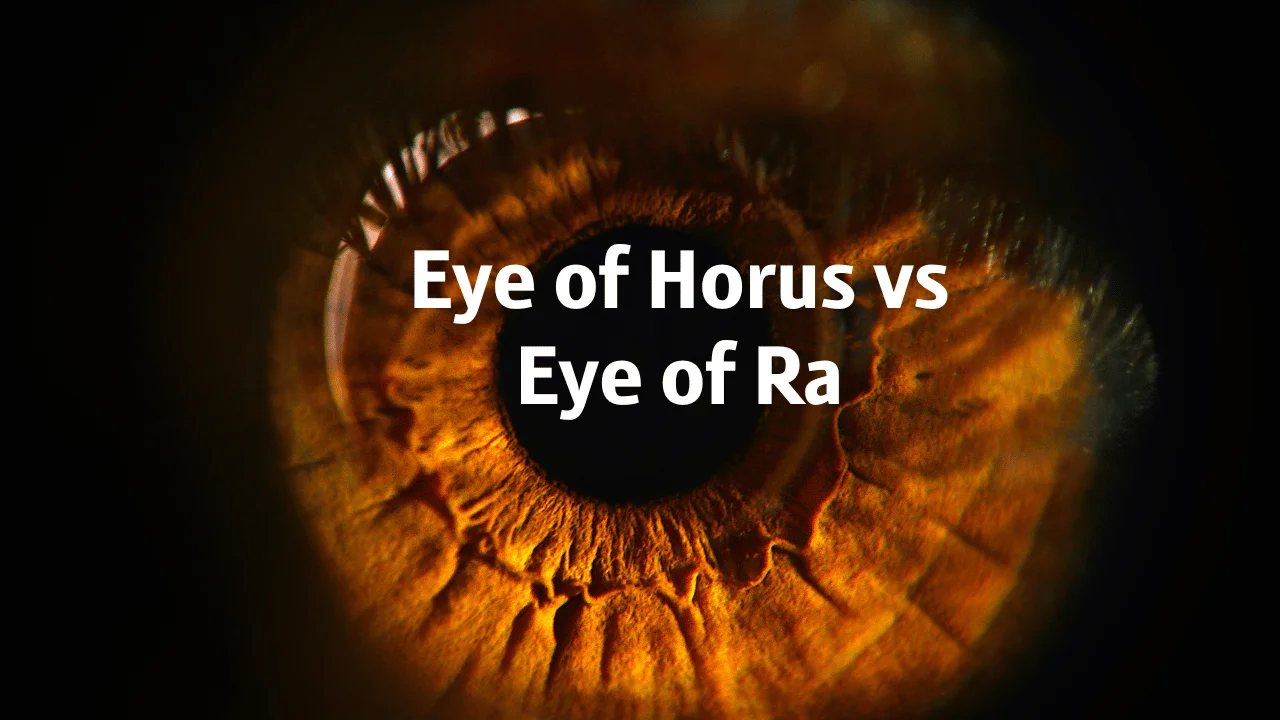Two symbols in Ancient Egyptian mythology—the Eye of Ra and the Eye of Horus—stand out for their mystical appeal and deep significance. In addition to representing Egypt’s diverse religious and cultural traditions, these artefacts from antiquity provide light on the influential beliefs that molded a people. Join me as I delve into the fascinating world of symbols, discovering their hidden meanings, rich history, and lasting impact. As we unravel the mysteries of these symbols, we’ll explore the captivating interplay between the Eye of Horus vs Eye of Ra, unraveling the intricate tapestry of Egyptian spirituality.
Ancient Egyptian Protection Symbols
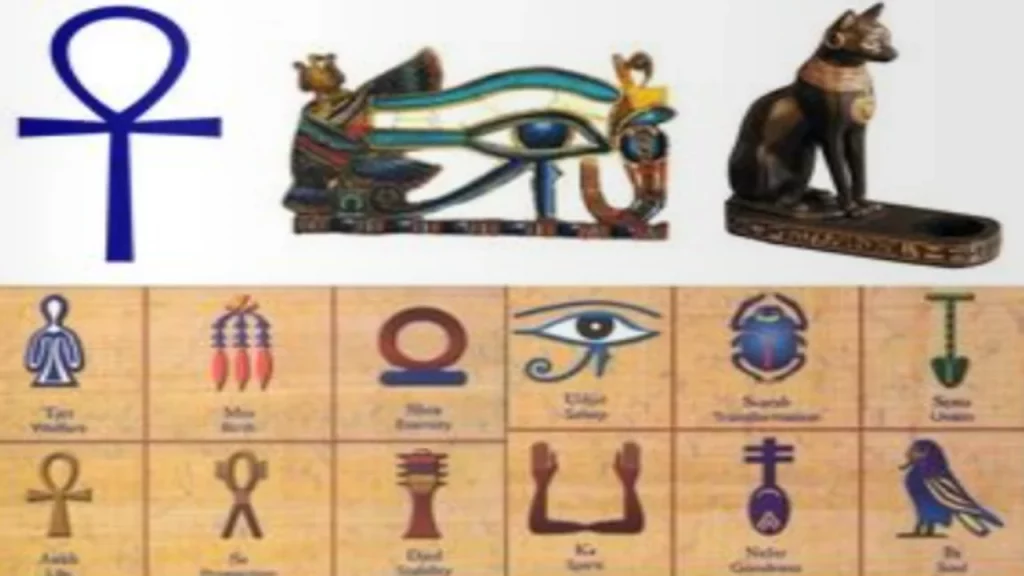
The Protective Eye of Horus
The sky god Horus, represented by the falcon, was highly esteemed in the Old Kingdom of Egypt for his curative and protective abilities. The moon’s left eye, or the Eye of Horus, stood as a symbol of power, authority, fairness, and the natural order. Worn as a protective amulet, it represented rebirth and healing and was associated with the goddess Mut. Its protective nature is highlighted by the fact that Thoth healed this eye after it was injured in a battle with Seth.
The Majestic Eye of Ra
On the flip side, the sun-like Eye of Ra was a potent emblem of inventiveness, foresight, and regal power. Many Egyptian goddesses, including Tefnut, Bast, and Sekhmet, revered it for its omniscience and the fact that it was frequently shown with a sun disc and a cobra. Pharaohs’ crowns prominently displayed the Eye of Ra, a celestial being dispatched by Ra to vanquish his adversaries. This eye served as a symbol of protection.
Sun and Moon Gods of Egypt
Even their heavenly manifestations reflect the ambivalence of these symbols. Harmony and balance in the cosmos are embodied by the Eye of Horus, which is connected to the moon, and the Eye of Ra, which is linked to the sun. These representations show how the Ancient Egyptians understood nature and had a strong bond with the universe.
Falcon God Mythology
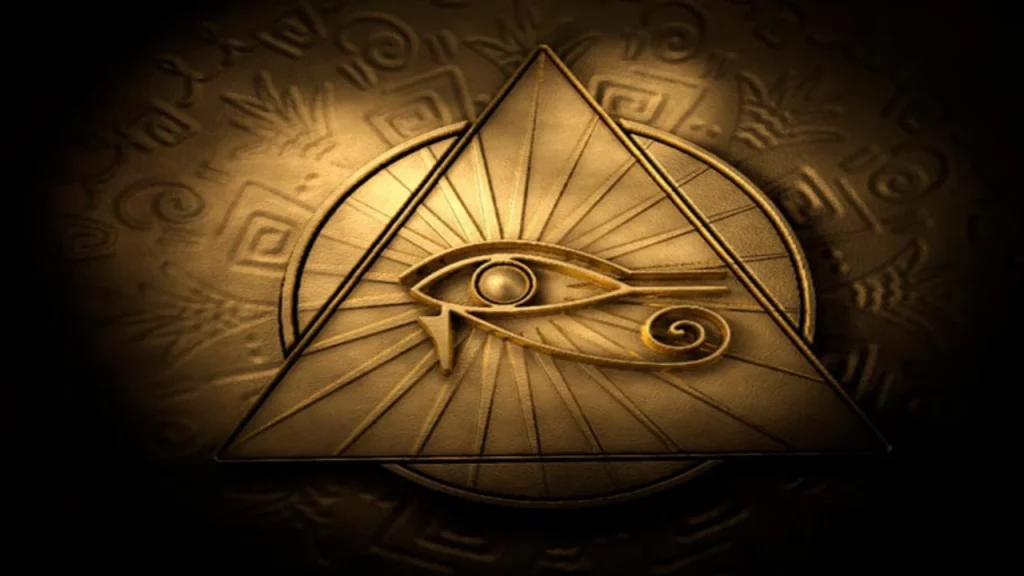
Because of the falcon’s holy status in Ancient Egyptian culture, it is common to see depictions of Horus and Ra with falcon features. The depiction emphasises the gods’ heavenly and protective qualities, which further establish their position in the Egyptian pantheon of gods.
Ancient Egyptian Amulets
The Eye of Horus Amulet
As a protective amulet for body and soul, the Eye of Horus was worn by the ancient Egyptians. It represented the Pharaoh’s protective role and was a sign of royal authority and good fortune.
The Eye of Ra Amulet
Amulets depicting the Eye of Ra were also thought to keep evil spirits at bay and promote peace. Amulets like this, worn by both commoners and pharaohs, attested to the efficacy of the Eye as a protector.
Thoth’s Healing Powers
An important part of Ancient Egyptian mythology involved the god Thoth, who healed Horus’s eye. This action not only healed Horus’s eye, but it also represented a return to harmony and stability, highlighting the protective powers of the eye.
Royal Authority in Ancient Egypt
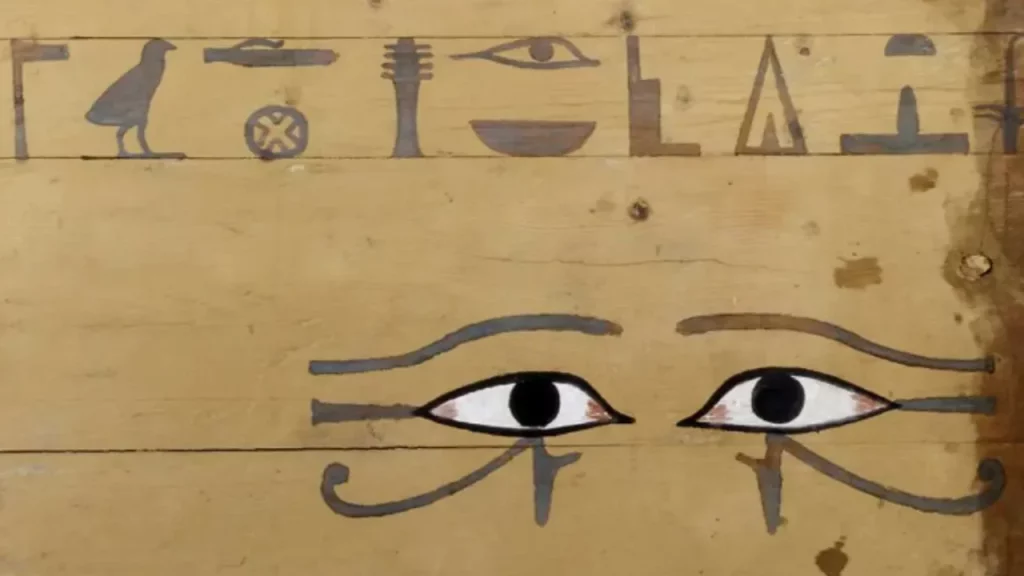
A key component of pharaonic authority was the Eye of Ra, which included both Horus and Ra. In addition to safeguarding the pharaohs, they fortified their position as deities and their ties to the divine.
Upper and Lower Egypt’s Deities
Wadjet, the goddess of the Eyes of Horus, and Nekhbet, the goddess of Ra, were the guardians of Lower Egypt and Upper Egypt, respectively. Their connection to these eyes emphasises the regional importance of the symbols and their function in bringing the kingdom together.
Egyptian Gods’ Battles
An important part of the mythology revolves around the fight between Horus and Seth, in which Horus lost an eye. Key concepts in Ancient Egyptian mythology include struggle, victory, and the reestablishment of order, all of which are portrayed here.
Ra’s All-Seeing Eye
A symbol of the sun god Ra’s omnipresence and ultimate creator and protector, the Eye of Ra has limitless vision powers.
Horus’s Protective Eye
The Eye of Horus, on the other hand, is associated with protection and stresses the need of keeping one’s physical and spiritual health in check. It represents strength and recovery, like the moon’s restoring power.
The Eye of Ra
In numerous myths, the Eye of Ra—a representation of the sun’s might—played a crucial role, such as Ra’s ascent through the heavens and his struggles in the underworld. The intricate and ever-changing bond between Ra and his eye is exemplified by its first defiance of the god and its eventual submission.
The Eye of Horus
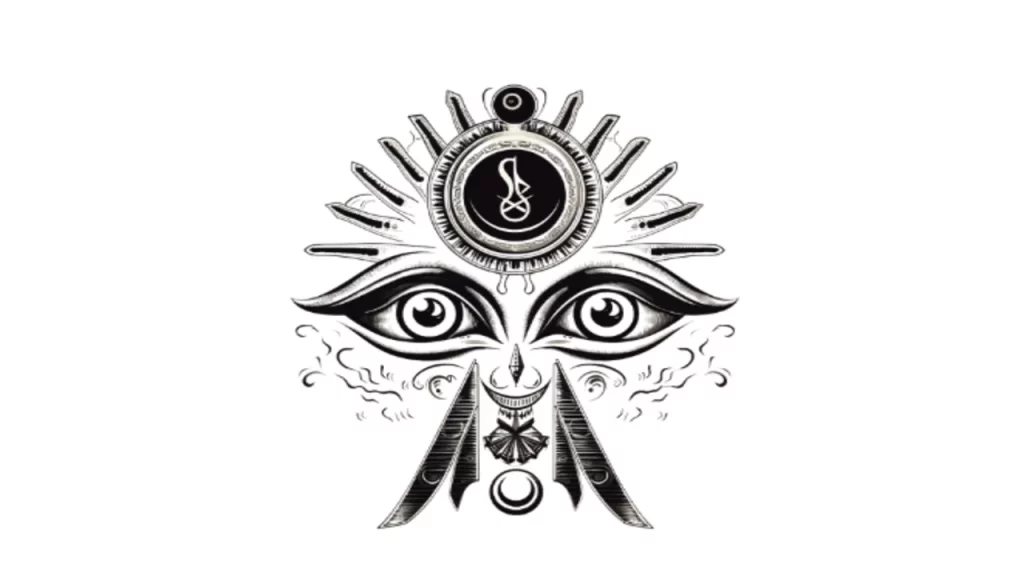
The story of Horus’s fight with Set and subsequent eye loss highlights themes of death, sacrifice, and rebirth. Restoration and the victory of righteousness over wickedness are symbolised by Thoth’s healing of his eye.
Resurrection Symbols in Egypt
In addition to its protective function, the Eye of Horus symbolises rebirth and the eternal cycle of life and death. The myth of Horus and his father, the god Osiris, who rules over the underworld, incorporates this idea profoundly. In keeping with ancient Egyptian beliefs in rebirth and the afterlife, Horus’s eye being healed following his fight with Seth represents rebirth and the restoration of wholeness.
Ancient Egyptian Sky Deities
In Egyptian mythology, the sky gods Horus and Ra were both very important. The sky was represented by Horus, who is typically shown as a falcon flying through the air. By contrast, Ra was king of the sky and oversaw the sun’s journey across the horizon in his role as sun god. The ancient Egyptians’ profound respect for the heavens and their faith in a divine relationship between the two are highlighted by their association with the sky.
Hathor, Protector of the Pharaoh
When it came to protecting the pharaoh, Hathor—who is often associated with the Eye of Ra—was indispensable. The belief that Hathor, in her ferocious form, would exact her vengeance on anyone who dared to threaten the pharaoh solidified the Eye of Ra’s status as a representation of the royal guardianship and power.
Mythological Symbols of Power
The Eye of Ra and the Eye of Horus were both potent emblems of divine power in addition to being protective amulets. The pharaohs, who were worshipped as gods in their own right, frequently made use of these symbols to proclaim their bond with Horus and Ra, thus establishing the divine right to govern.
Cultural Legacy of the Eye of Horus in Modern Times
The Eye of Horus has had an impact on culture from antiquity to the present day. It represents wisdom and protection and is a common sight in artwork, jewellery, and even mainstream media. Ancient Egyptian artistry is on full display in its unique design, which never fails to awe and amaze.
Theological Interpretation of the Eye of Ra’s Rebellious Nature
An interesting theological angle is provided by the Eye of Ra’s sporadic defiance of its maker. This part of the Eye represents the ever-changing and even dangerous connection between creator and creation. Additionally, it reveals how the ancient Egyptians perceived the equilibrium between disorder and order.
Transformative Power of the Eye of Ra
In addition to representing death and destruction, the Eye of Ra represented new beginnings and metamorphosis. The symbol’s transformation from a vengeful force to the protective Uraeus on Ra’s crown exemplifies its transformative power, reflecting the natural world’s cyclical nature.
Horus’s Role in Unifying Egypt
The mythology of Horus is also crucial to the unification of Ancient Egyptian religion. Horus, the Egyptian god associated with the sky and the monarch, represented the pharaoh’s function as a unifier and guardian of the land. The bond between god and pharaoh played a crucial role in keeping Ancient Egyptian society together politically and culturally.
The Eye of Ra in Egyptian Art and Architecture
The Eye of Ra is a recurrent motif in ancient Egyptian art and architecture, highlighting its significance in religious and royal settings. Its sarcophagi, temple sculptures, and tomb paintings all attest to its status as a protector and emblem of heavenly authority.
The Enduring Mystique of Ancient Egyptian Symbols
Last but not least, the Eye of Ra and the Eye of Horus are more than just symbols from antiquity; they reveal the very essence of a gone culture. Their enduring influence on contemporary culture, complex mythology, and wealth of symbolic meaning never cease to amaze and motivate. Reminding us of the enduring mysteries and deep wisdom of Ancient Egypt, these symbols represent power, the heavens, and protection.
FAQs
What are the main differences between the Eye of Horus and the Eye of Ra?
The Eye of Horus, representing the moon, is a symbol of protection, healing, and resurrection, while the Eye of Ra, symbolizing the sun, embodies creative energy, vision, and royal authority.
How were the Eye of Horus and the Eye of Ra used in Ancient Egypt?
Both were used as protective amulets, featured in religious practices, and symbolized pharaonic power and authority.
What is the significance of the Eye of Horus in battles?
The Eye of Horus, damaged and later healed in his battle with Seth, symbolizes triumph over adversity and the restoration of order.
Why was the Eye of Ra considered all-seeing?
The Eye of Ra, representing the sun, was believed to have unlimited vision powers, symbolizing the sun god’s omnipresence and protective nature.
Are the Eye of Horus and the Eye of Ra still relevant today?
Yes, these symbols continue to influence modern culture and spirituality, representing protection, power, and a connection to ancient wisdom.
For More Visit: Nixon Lewis Funeral Home Obituaries
Conclusion
The cultural and mythological importance of the Eye of Ra and the Eye of Horus ensures that they will always be fascinating and meaningful symbols. These ancient Egyptian icons, the Eye of Horus and the Eye of Ra, have transcended the boundaries of time, leaving an indelible mark on contemporary culture, art, and spirituality. From ancient times to the present day, the enigmatic allure of these symbols persists, offering glimpses into the mysteries of the cosmos. The Eye of Horus vs Eye of Ra debate only adds to their intrigue, as enthusiasts and scholars explore the nuances of their symbolism, further enriching their significance as reminders of strength, power, and the celestial harmony that resonates through the ages.

Aretha Davis, the wordsmith extraordinaire, weaves enchanting tales with her pen and keyboard. A renowned blogger and writer, her captivating prose transports readers to realms unknown. Join her literary journey and be swept away by the magic of her words.
